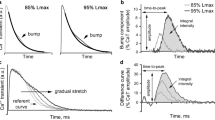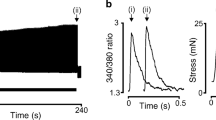Abstract
The present study examined the contribution of myofilament contractile proteins to regional function in guinea pig myocardium. We investigated the effect of stretch on myofilament contractile proteins, Ca2+ sensitivity, and cross-bridge cycling kinetics (K tr) of force in single skinned cardiomyocytes isolated from the sub-endocardial (ENDO) or sub-epicardial (EPI) layer. As observed in other species, ENDO cells were stiffer, and Ca2+ sensitivity of force at long sarcomere length was higher compared with EPI cells. Maximal K tr was unchanged by stretch, but was higher in EPI cells possibly due to a higher α-MHC content. Submaximal Ca2+-activated K tr increased only in ENDO cells with stretch. Stretch of skinned ENDO muscle strips induced increased phosphorylation in both myosin-binding protein C and myosin light chain 2. We concluded that transmural MHC isoform expression and differential regulatory protein phosphorylation by stretch contributes to regional differences in stretch modulation of activation in guinea pig left ventricle.




Similar content being viewed by others
References
Allen DG, Kentish JC (1988) Calcium concentration in the myoplasm of skinned ferret ventricular muscle following changes in muscle length. J Physiol 407:489–503
Balnave CD, Allen DG (1996) The effect of muscle length on intracellular calcium and force in single fibres from mouse skeletal muscle. J Physiol 492:705–713
Borbely A, van der Velden J, Papp Z, Bronzwaer JG, Edes I, Stienen GJ, Paulus WJ (2005) Cardiomyocyte stiffness in diastolic heart failure. Circulation 111:774–781
Brenner B, Eisenberg E (1986) Rate of force generation in muscle: correlation with actomyosin ATPase activity in solution. Proc Natl Acad Sci USA 83:3542–3546
Bugaisky LB, Anderson PG, Hall RS, Bishop SP (1990) Differences in myosin isoform expression in the subepicardial and subendocardial myocardium during cardiac hypertrophy in the rat. Circ Res 66:1127–1132
Cazorla O, Freiburg A, Helmes M, Centner T, Mcnabb M, Wu Y, Trombitas K, Labeit S, Granzier H (2000) Differential expression of cardiac titin isoforms and modulation of cellular stiffness. Circ Res 86:59–67
Cazorla O, Le Guennec JY, White E (2000) Length–tension relationships of sub-epicardial and sub-endocardial single ventricular myocytes from rat and ferret hearts. J Mol Cell Cardiol 32:735–744
Cazorla O, Pascarel C, Garnier D, Le Guennec JY (1997) Resting tension participates in the modulation of active tension in isolated guinea pig ventricular myocytes. J Mol Cell Cardiol 29:1629–1637
Cazorla O, Szilagyi S, Le Guennec JY, Vassort G, Lacampagne A (2005) Transmural stretch-dependent regulation of contractile properties in rat heart and its alteration after myocardial infarction. Faseb J 19:88–90
Cazorla O, Szilagyi S, Vignier N, Salazar G, Kramer E, Vassort G, Carrier L, Lacampagne A (2006) Length and protein kinase A modulations of myocytes in cardiac myosin binding protein C-deficient mice. Cardiovasc Res 69:370–380
Cazorla O, Vassort G, Garnier D, Le Guennec JY (1999) Length modulation of active force in rat cardiac myocytes: is titin the sensor. J Mol Cell Cardiol 31:1215–1227
Cazorla O, Wu Y, Irving TC, Granzier H (2001) Titin-based modulation of calcium sensitivity of active tension in mouse skinned cardiac myocytes. Circ Res 88:1028–1035
Chan JY, Takeda M, Briggs LE, Graham ML, Lu JT, Horikoshi N, Weinberg EO, Aoki H, Sato N, Chien KR, Kasahara H (2008) Identification of cardiac-specific myosin light chain kinase. Circ Res 102:571–580
Clement O, Puceat M, Walsh MP, Vassort G (1992) Protein kinase C enhances myosin light-chain kinase effects on force development and ATPase activity in rat single skinned cardiac cells. Biochem J 285:311–317
Davis JS, Hassanzadeh S, Winitsky S, Lin H, Satorius C, Vemuri R, Aletras AH, Wen H, Epstein ND (2001) The overall pattern of cardiac contraction depends on a spatial gradient of myosin regulatory light chain phosphorylation. Cell 107:631–641
Eisenberg BR, Edwards JA, Zak R (1985) Transmural distribution of isomyosin in rabbit ventricle during maturation examined by immunofluorescence and staining for calcium-activated adenosine triphosphatase. Circ Res 56:548–555
Farman GP, Walker JS, de Tombe PP, Irving TC (2006) Impact of osmotic compression on sarcomere structure and myofilament calcium sensitivity of isolated rat myocardium. Am J Physiol Heart Circ Physiol 291:H1847–1855
Fukuda N, Sasaki D, Ishiwata S, Kurihara S (2001) Length dependence of tension generation in rat skinned cardiac muscle: role of titin in the Frank–Starling mechanism of the heart. Circulation 104:1639–1645
Fukuda N, Wu Y, Farman G, Irving TC, Granzier H (2003) Titin isoform variance and length dependence of activation in skinned bovine cardiac muscle. J Physiol (Lond) 553:147–154
Granzier HL, Irving TC (1995) Passive tension in cardiac muscle: contribution of collagen, titin, microtubules, and intermediate filaments. Biophys J 68:1027–1044
Granzier HL, Labeit S (2004) The giant protein titin: a major player in myocardial mechanics, signaling, and disease. Circ Res 94:284–295
Grimm M, Mahnecke N, Soja F, El-Armouche A, Haas P, Treede H, Reichenspurner H, Eschenhagen T (2006) The MLCK-mediated alpha1-adrenergic inotropic effect in atrial myocardium is negatively modulated by PKCepsilon signaling. Br J Pharmacol 148:991–1000
Harris SP, Rostkova E, Gautel M, Moss RL (2004) Binding of myosin binding protein-C to myosin subfragment S2 affects contractility independent of a tether mechanism. Circ Res 95:930–936
Herring BP, England PJ (1986) The turnover of phosphate bound to myosin light chain-2 in perfused rat heart. Biochem J 240:205–214
Hibberd MG, Jewell BR (1982) Calcium-and length-dependent force production in rat ventricular muscle. J Physiol 329:527–540
High CW, Stull JT (1980) Phosphorylation of myosin in perfused rabbit and rat hearts. Am J Physiol 239:H756–H764
Hofmann PA, Fuchs F (1987) Effect of length and cross-bridge attachment on Ca2+ binding to cardiac troponin C. Am J Physiol 253:C90–C96
Hofmann PA, Hartzell HC, Moss RL (1991) Alterations in CA2+ sensitive tension due to partial extraction of c-protein from rat skinned cardiac myocytes and rabbit skeletal muscle fibers. J Gen Physiol 97:1141–1163
Kentish JC, Mccloskey DT, Layland J, Palmer S, Leiden JM, Martin AF, Solaro RJ (2001) Phosphorylation of troponin I by protein kinase A accelerates relaxation and crossbridge cycle kinetics in mouse ventricular muscle. Circ Res 88:1059–1065
Kobayashi T, Solaro RJ (2005) Calcium, thin filaments, and the integrative biology of cardiac contractility. Annu Rev Physiol 67:39–67
Konhilas JP, Irving TC, de Tombe PP (2002) Myofilament calcium sensitivity in skinned rat cardiac trabeculae: role of interfilament spacing. Circ Res 90:59–65
Konhilas JP, Irving TC, Wolska BM, Jweied EE, Martin AF, Solaro RJ, Tombe PPD (2003) Troponin I in the murine myocardium: influence on length-dependent activation and interfilament spacing. J Physiol (Lond) 547:951–961
Korte FS, McDonald KS (2007) Sarcomere length dependence of rat skinned cardiac myocyte mechanical properties: dependence on myosin heavy chain. J Physiol 581:725–739
Kruger M, Kohl T, Linke WA (2006) Developmental changes in passive stiffness and myofilament Ca2+ sensitivity due to titin and troponin-I isoform switching are not critically triggered by birth. Am J Physiol Heart Circ Physiol 291:H496–H506
Morano I (1999) Tuning the human heart molecular motors by myosin light chains. J Mol Med 77:544–555
Moss RL, Fitzsimons DP (2002) Frank-starling relationship: long on importance, short on mechanism. Circ Res 90:11–13
Neagoe C, Opitz CA, Makarenko I, Linke WA (2003) Gigantic variety: expression patterns of titin isoforms in striated muscles and consequences for myofibrillar passive stiffness. J Muscle Res Cell Motil 24:175–189
Olsson MC, Patel JR, Fitzsimons DP, Walker JW, Moss RL (2004) Basal myosin light chain phosphorylation is a determinant of Ca2+ sensitivity of force and activation dependence of the kinetics of myocardial force development. Am J Physiol Heart Circ Physiol 287:H2712–2718
Pearson JT, Shirai M, Tsuchimochi H, Schwenke DO, Ishida T, Kangawa K, Suga H, Yagi N (2007) Effects of sustained length-dependent activation on in situ cross-bridge dynamics in rat hearts. Biophys J 24:4319–4329
Pi Y, Zhang D, Kemnitz KR, Wang H, Walker JW (2003) Protein kinase C and A sites on troponin I regulate myofilament CA2+ sensitivity and ATPase activity in the mouse myocardium. J Physiol 552:845–857
Pohlmann L, Kroger I, Vignier N, Schlossarek S, Kramer E, Coirault C, Sultan KR, El-Armouche A, Winegrad S, Eschenhagen T, Carrier L (2007) Cardiac myosin-binding protein C is required for complete relaxation in intact myocytes. Circ Res 101:928–938
Pyle WG, Solaro RJ (2004) At the crossroads of myocardial signaling: the role of Z-discs in intracellular signaling and cardiac function. Circ Res 94:296–305
Rundell VLM, Manaves V, Martin AF, de tombe PP (2005) Impact of {beta}-myosin heavy chain isoform expression on cross-bridge cycling kinetics. Am J Physiol Heart Circ Physiol 288:H896–H903
Stelzer JE, Fitzsimons DP, Moss RL (2006) Ablation of myosin-binding protein-C accelerates force development in mouse myocardium. Biophys J 90:4119–4127
Stelzer JE, Moss RL (2006) Contributions of stretch activation to length-dependent contraction in murine myocardium. J Gen Physiol 128:461–471
Stelzer JE, Patel JR, Walker JW, Moss RL (2007) Differential roles of cardiac myosin-binding protein C and cardiac troponin I in the myofibrillar force responses to protein kinase A phosphorylation. Circ Res 101:503–511
Van der Velden J, Papp Z, Boontje NM, Zaremba R, de jong JW, Janssen PML, Hasenfuss G, Stienen GJM (2003) The effect of myosin light chain 2 dephosphorylation on Ca2+-sensitivity of force is enhanced in failing human hearts. Cardiovasc Res 57:505–514
Vannier C, Chevassus H, Vassort G (1996) Ca-dependence of isometric force kinetics in single skinned ventricular cardiomyocytes from rats. Cardiovasc Res 32:580–586
Winegrad S (1999) Cardiac myosin binding protein C. Circ Res 84:1117–1126
Witt CC, Gerull B, Davies MJ, Centner T, Linke WA, Thierfelder L (2000) Hypercontractile properties of cardiac muscle fibers in a knock-in mouse model of cardiac myosin-binding protein-C. J Biol Chem 84:10
Acknowledgements
This work was supported by the “Association Française contre les Myopathies”, and “Région Languedoc-Roussillon”. OC is an established investigator of CNRS. PPT was supported by INSERM and NIH grants HL-62426; HL-75494; HL-77195. Thanks are due to Guillermo Salazar for technical assistance.
Author information
Authors and Affiliations
Corresponding author
Rights and permissions
About this article
Cite this article
Ait mou, Y., le Guennec, JY., Mosca, E. et al. Differential contribution of cardiac sarcomeric proteins in the myofibrillar force response to stretch. Pflugers Arch - Eur J Physiol 457, 25–36 (2008). https://doi.org/10.1007/s00424-008-0501-x
Received:
Revised:
Accepted:
Published:
Issue Date:
DOI: https://doi.org/10.1007/s00424-008-0501-x




